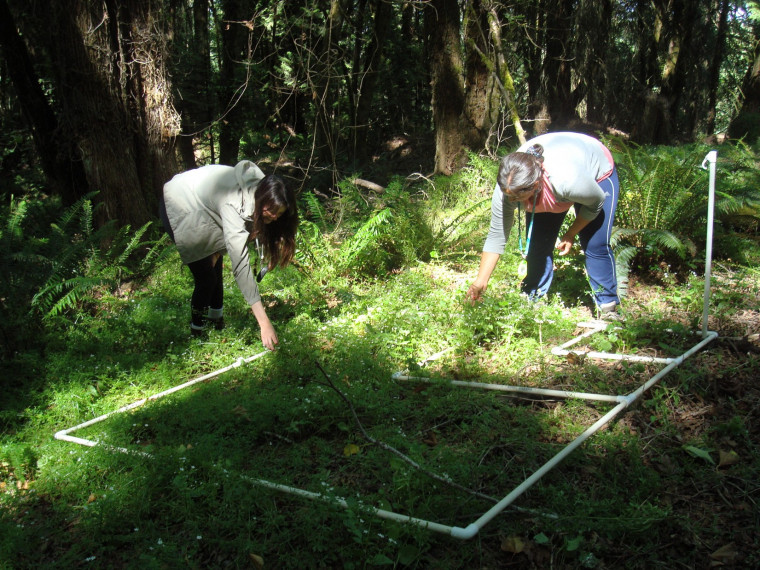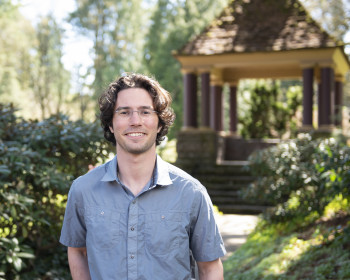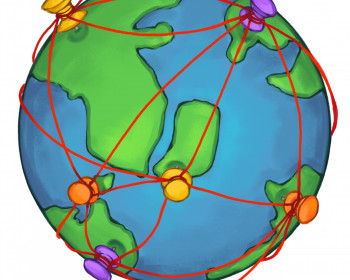Students investigate the effects of invasive plant species removal
Open gallery

During the summer, Lewis & Clark students continue to work hard in their fields of study. By collaborating with faculty on research projects, students are able to engage their curiosity, expand their learning, and prepare for life after college, all while making meaningful contributions to scholarship.
Michelle Garfias ’15 and Janel Hull ’15 worked with Paulette Bierzychudek, William Swindells Sr. Professor of Natural Sciences, to study the effect of removing invasive plant species from River View Natural Area in Southwest Portland. They wanted to know how the forest plant community responded to this removal—if the plant species would return, and whether or not further intervention is needed to restore the full community of native plant species. In the following Q&A, the team members reflects on their experience:
Does your research have any potential applications in the real world, or will it influence other work in your field?
Bierzychudek: The answer to both questions is absolutely yes. This project has a strongly applied focus since our goal is to provide information that will help Portland Parks & Recreation decide how best to manage this and other natural areas in Portland. And because invasive removal is becoming an increasingly common land management strategy but has been little-studied, we expect that our work, once published, will be used by land managers throughout the Pacific Northwest and perhaps more widely.
Hull: On a small scale, our research will help the City of Portland be able to make informed decisions about the management of River View Natural Area. We can tell them what native plant species are doing well and which are not. We can tell them if invasive species are returning or if new ones are appearing. On a large scale, our research can help land managers worldwide understand how to manage invasive plant species more effectively.
What is it like to have your research take place off campus?
Garfias: We’ve spent most of our time working in River View Natural Area and working there has been a beautiful experience. I feel really close to this forest now, especially now that I can recognize any plant species in there. We’ve gotten to see more of the forest by bushwhacking through it, falling, and getting cut by berry bushes. I’ve also never had as many mosquito bites as I did while working in River View, but all of that just comes with the forest…all of that and more! I feel really grateful for being allowed to participate in such an important research project. I learned more than I could have ever imagined and I would absolutely do it again if I could.
Hull: Our research requires us to be familiar with all of the plant species that show up in River View, so we’ve devoted a lot of time to identifying different plants. We can identify anything from canopy trees to tiny seedlings to mangled shrubs. We’ve discovered salamanders, deer bones, and beautiful native wildflowers along the way. I’ve loved working in River View; it makes me feel connected to my local environment and appreciate Oregon’s natural beauty even more.
What first sparked your interest in this research area?
Hull: I grew up in New Zealand, which is particularly sensitive country to invasive species. A couple of years ago, they created a wildlife sanctuary right by my house there and built a giant fence around the whole thing to keep out invasive animals. Upon coming to college and taking environmental studies classes, I’ve learned how complex of an issue nonnative species introductions really are. It is certainly not as black and white as I thought it was. This hands on research project lets me learn objectively what effect invasive species are having in this ecosystem.
Garfias: I applied to this project because I knew that Paulette was a great instructor and was so knowledgeable. I thought working with her on anything would be such a joy. Also my scientific interests range on such a wide spectrum and ecology is one of the areas that really sparked my interest. As a kid I spent my time outdoors, touching bugs, playing in mud, and gardening. I was fortunate to work with Paulette and Janel on such an interesting investigation.
How has working closely with faculty influenced your education?
Hull: Working with Paulette has been so fun. I feel really lucky to have the opportunity to work side by side with such a passionate and knowledgeable professor. I’ve enjoyed being given autonomy to do important research while also having a professor to talk to when I need help. Paulette does a great job of both trusting and supporting us. It has been a learning intensive and exciting work environment.
Garfias: During a normal semester in any class, you learn so much! But I’ve seen that working with a professor and one other student, has been just as enriching, if not more. Paulette has taught us some of the most interesting things regarding plants, trees, birds, deer, and more. She is so knowledgeable and passionate about her work and I strive to be more like her. Now that I have worked so closely with her, I see her as more than a professor and it really helps to see that such a great professor is still learning and still makes mistakes. It makes me feel better about all the mistakes I make. Now that I’ve participated in this internship, I feel more confident going into my third year as a biology major.
How do you hope your experiences this summer will impact your future studies or professional pursuits?
Hull: I definitely want to keep working outdoors and within the ecology field. This internship has given me a foundational knowledge that I will continue to build upon. There is still so much to learn and discover, and this experience has excited my curiosity to do so.
Garfias: This internship has given me a strong foundation scientifically and in the working world. I haven’t taken enough science classes to exactly know what I will pursue in graduate school, but graduate school is definitely what I want to do after Lewis & Clark. While I was out in the field collecting data, it made me realize how much I enjoyed working outdoors and if I could do something like that as a future job, I would be more than happy.
Anything else you’d care to add?
Hull: Riverview is still a very sensitive forest in the process of recovering. Sadly, we’ve noticed a lot of fire pits, trash, and general human disturbance in the forest. It would be awesome if Lewis and Clark students could help the local forest recover by reducing their impact. Staying on trails, removing all trash, and not creating any fires would make a huge difference. We can all take part in helping River View forest fully recover!
About the program
The John S. Rogers Science Research Program allows students to participate in graduate-level research with an emphasis on strengthening their communication skills by requiring them to present their findings. This summer, 40 students are pursuing topics that range from artificial intelligence and motivating behavior to holographic tweezers and zebra fish. Working closely with peers and faculty members, students undertake research questions and present their work in two public venues.
“We’re not asking you, ‘What’s the answer?’ We’re saying, ‘What’s the question?’” said Michael Broide, director of the Rogers program and chair of the physics department. “I think what sets our program apart is that regardless of what project you are on, we’re all going to come together as a group to present what we’re doing in as accessible a way as possible. In science, it’s such an important skill to be able to explain cogently what you’re doing.”
Students make their final research presentation at the Rogers summer science poster session, held in conjunction with the Science Without Limits Symposium. Scheduled for September 18, the poster session is free and open to the public.
Department of Biology Rogers Summer Research Projects
Zibby Pillote ’14 contributed to this story.
More Newsroom Stories
Public Relations is located in McAfee on the Undergraduate Campus.
MSC: 19
email public@lclark.edu
voice 503-768-7970
Public Relations
Lewis & Clark
615 S. Palatine Hill Road MSC 19
Portland OR 97219

